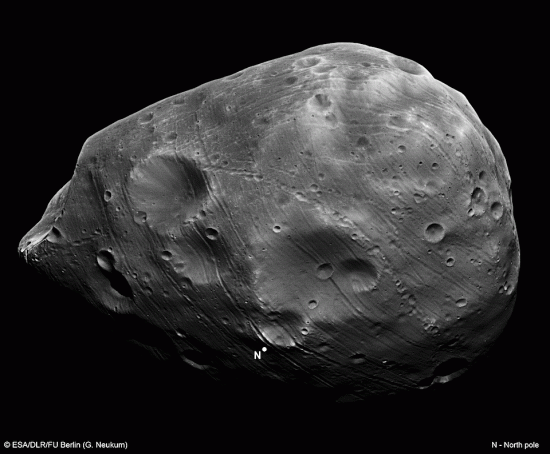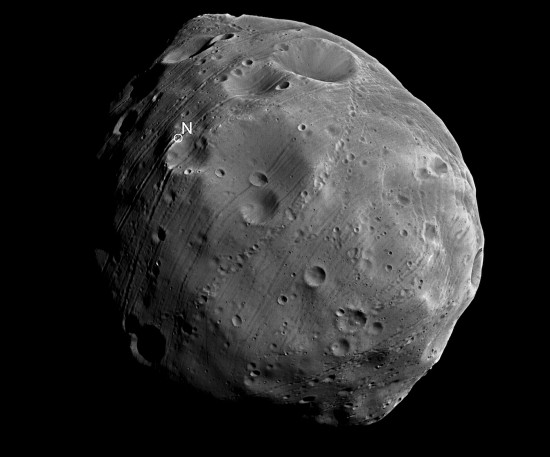Nov 1, 2017
Phobos could be electrically charged.
Of the two Martian moons, Phobos is the largest, at 28 by 20 kilometers. Its most prominent feature is Stickney crater, a ten-kilometer-wide excavation that is almost as large as Phobos, itself. If the crater was caused by the impact of an asteroid, it should have blasted the moon into fragments, yet there is little sign of any blast debris.
There are what appear to be fracture lines around Stickney, so some astronomers assert that they are evidence for a severe shock, and that they were distorted by an impact. Closer examination reveals that the striations are, in reality, chains of small craters and not cracks. In fact, the crater is rounded and smooth, with no large breccias, although Phobos is covered with almost a meter of ultra-fine dust.
Phobos is about the same size as asteroids Mathilde, Eros and Ida, and it exhibits features like the relatively gigantic craters that are endemic to those bodies, so what is the common event that creates such similar structures without obliterating the objects in the first place? The answer is electricity.
In previous Pictures of the Day about Mars, scenarios for how it was devastated by electric arcs in the recent past were presented. Those events gouged-out Valles Marineris, Olympus Mons and Arabia Terra in a relatively short period, ejecting gigatons of rock from the planet. Could it be that Phobos and Deimos are remnants of that overwhelming cataclysm?
The thunderbolts that carved up Mars threw big chunks of its crust into orbit, as well as into long ellipses around the Sun. They were smoothed and eroded by the arcs while accelerating through the planet’s electric fields. Touchdown points where the electric discharges were most intense became deeply incised craters. That is why Phobos and the asteroids mentioned are covered in dust, have little or no large boulders, and are defined by huge craters that look like they are half-melted.
Phobos is composed of iron oxide, silicon dioxide, various carbonates and other ceramic compounds, so it is nearly identical to the surface composition of Mars. According to a recent press release, the presence of so much dust could present a problem to any missions designed to land on the moon because, “… powerful solar eruptions could electrically charge areas of the Martian moon Phobos to hundreds of volts…”
In 1998, the Lunar Prospector detected a surprisingly high voltage as it passed through Earth’s magnetotail, a part of the plasma sheath that envelops our planet. The Moon passes through it once a month during full moon phase; the electric differential was found to occur during that passage. The Moon passage through the ionized plasma affects materials in the lunar regolith. Electrons accumulate, producing a negative charge on the ultra-fine dust particles, causing them to repel each other and drift off the surface. Charge differential between the day and night side of the Moon has been measured at more than 1000 volts.
The press release states that the solar wind charges Phobos. When charged particles strike its day side, they are absorbed by the surface, which might cause astronauts and rovers to accumulate significant electric charges: up to ten thousand volts in some materials. Special electric charge dispersal systems will be needed in order to prevent arcing to instruments or to oppositely charged surface materials.
Stephen Smith





